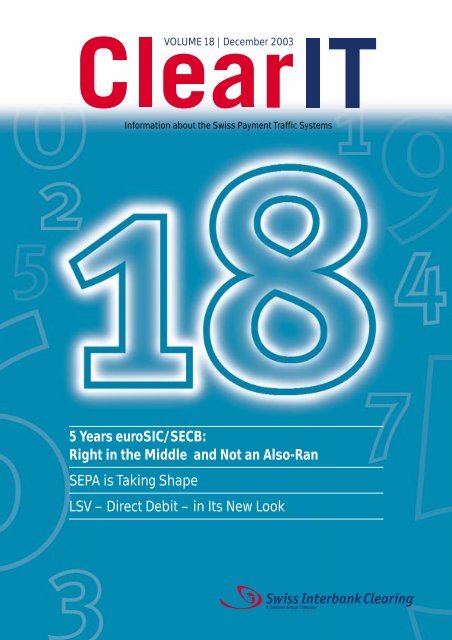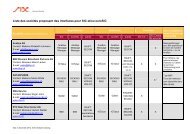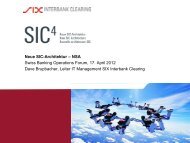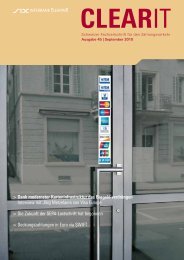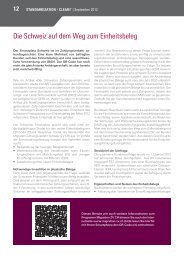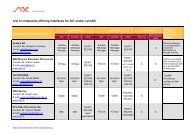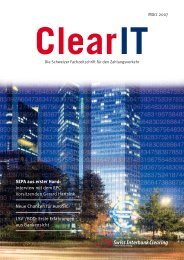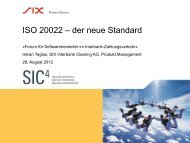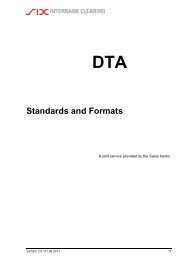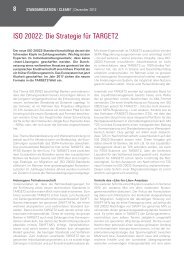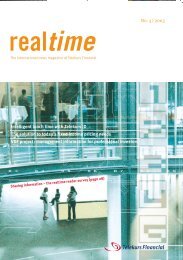Create successful ePaper yourself
Turn your PDF publications into a flip-book with our unique Google optimized e-Paper software.
Information about the Swiss Payment Traffic Systems<br />
5 Years euroSIC/SECB:<br />
Right in the Middle and <strong>No</strong>t an Also-Ran<br />
SEPA is Taking Shape<br />
VOLUME <strong>18</strong> | December 2003<br />
LSV – Direct Debit – in Its New Look
Content ClearIT, Edition <strong>18</strong><br />
EDITORIAL 3<br />
SINGLE EURO PAYMENTS AREA (SEPA) IS TAKING SHAPE 4<br />
«The central question concerning the development of a joint European<br />
payment traffic system is less a question of centralized infrastructures<br />
than one of joint and uniform standards.» Dr. H.-J. Friederich of the<br />
Deutsche Bundesbank takes a look at the road toward a unified European<br />
payment traffic zone.<br />
RIGHT IN THE MIDDLE AND NOT AN ALSO-RAN –<br />
EUROSIC/SECB CELEBRATES FIVE SUCCESSFUL YEARS 7<br />
euroSIC via SECB provides the Swiss financial center access to all 15<br />
European RTGS systems in euro. A look back at a successful chapter in<br />
Swiss financial history with articles by Jörg Auer (UBS), André Bamat<br />
(Swiss <strong>Interbank</strong> <strong>Clearing</strong>) and Horst W. Sander (SECB).<br />
A NEW DIRECT DEBIT PROCESS (LSV) STARTING<br />
IN SUMMER OF 2005 12<br />
Numerous ongoing communications among Swiss financial institutions,<br />
as well as a market research analysis, point the way toward a more modern,<br />
more efficient solution for this electronic payment traffic system.<br />
DELIVERY TO MINISIC VIA payCOM web 15<br />
During this year’s miniSIC emergency drill, payCOM web<br />
was employed as a new delivery channel.<br />
2
Will Switzerland become a payment island? Would we be alone in our isolation, surrounded by a euro world? These were the questions we were<br />
asking ourselves seven years ago before the new uniform currency was introduced in Europe. As an «out-out» country (a member of neither the EU<br />
nor the monetary union), yet with varied payment streams to our euro neighbor countries, it was crucial for us to create a way for the Swiss finan-<br />
cial center to have easy and convenient access to Euroland - and, wherever possible, with the same level of convenience and the same processes<br />
that we had been used to in our Swiss franc payment traffic! It was a courageous step for the governing board of the Swiss Bankers Association to<br />
vote for our suggestion to build a euroSIC parallel to our SIC system in Switzerland, and along with it, to found the SECB Swiss Euro <strong>Clearing</strong> Bank<br />
GmbH in Frankfurt, Germany, as its «overseer» to take on the function of a central bank for euroSIC.<br />
This solution, which was implemented in record time by the Swiss financial center with the customary cooperation among all participants, is now<br />
«a recognized concept as a fully developed technical solution» (see interview with H.-J. Friederich). euroSIC, the only euro payment traffic system<br />
operating 24 hours per day, went off without a hitch right from the start. remoteGATE, the remote access to euroSIC, additionally enhanced the<br />
attractiveness of our solution. By now, national banks and foreign institutions from six countries are using our SWIFT-compatible access to the<br />
Swiss payment traffic systems. It’s reasonably priced and can be integrated directly into the existing in-house applications and operational pro-<br />
cesses. Taking this courageous step has certainly proven to be the right decision; it has resulted in the Swiss financial center being able to take an<br />
active part in the development of European payment traffic.<br />
DEAR READER<br />
But time does not stand still. The development of SEPA (Single Euro Payments Area), as well as the new direct debit system (see corresponding<br />
article on page 12), is already providing new, formidable challenges. Let’s get down to business, tackling these issues with the same energy and<br />
alacrity with which we have approached previous ones, and with our proven excellent cooperation!<br />
Stephan Zimmermann, Member, Chairman of the Board of Directors of Telekurs Group<br />
Editorial<br />
3
Swiss <strong>Interbank</strong> <strong>Clearing</strong> ClearIT, Edition <strong>18</strong><br />
SEPA IS TAKING SHAPE<br />
ClearIT: The European Commission<br />
and the European Central Bank have<br />
declared creating a SEPA the most<br />
important project in retail payment<br />
traffic. What will the connected EU<br />
payment infrastructure collective<br />
look like?<br />
Dr. H.-J. Friederich: Collective is<br />
mentioned all too readily, in my opinion.<br />
I don’t necessarily believe that a<br />
large clearing house with mandatory<br />
participation for everyone in Europe<br />
is the perfect solution. Aside from the<br />
fact that such a monopolistic solution<br />
would be considered a constraint, it<br />
would annul specific market forces.<br />
That cannot be the right vision for<br />
Europe. Of course we should cooperate<br />
wherever possible and economically<br />
reasonable. A decentralized<br />
solution, perhaps in the form of a<br />
network of interconnected European<br />
clearing houses, is indeed attainable.<br />
Certainly, bilateral streams, such as<br />
those between the large bank groups,<br />
could continue to exist. The triedand-tested<br />
patterns that have been<br />
established nationally or even crossborder<br />
in some countries, like the<br />
postal institutions’ Eurogiro, can<br />
certainly remain active. My vision of a<br />
SEPA includes the coexistence of and<br />
competition among clearing systems.<br />
Forcing the individual participants to<br />
go against their will would hardly produce<br />
a positive result. The institutions<br />
should certainly be given a<br />
4<br />
choice of which system they wish to<br />
connect to. It is important to enable<br />
interoperability among the various<br />
solutions. And this requires a uniform<br />
standard. The central question concerning<br />
the development of a<br />
common European payment traffic is<br />
therefore less about the centrality of<br />
the infrastructures, but much more a<br />
question about uniform standards.<br />
Only when all parties involved agree<br />
to use a common standard will SEPA<br />
become a reality. This guarantees a<br />
choice from among the various infrastructures<br />
with the competition leading<br />
to consolidation as a result.<br />
<strong>No</strong> lasting government subsidies<br />
The European Central Bank ECB<br />
would like to see minimally 50% of<br />
the cross-border euro volume and a<br />
part of the national payments on a<br />
pan-European payment infrastructure<br />
by the middle of 2004. How will<br />
attainment of that goal be verified,<br />
and what happens if these systems<br />
do not reach critical mass by the<br />
intended time?<br />
The only pan-European infrastructure<br />
currently in existence and able to<br />
achieve a consolidation beyond existing<br />
alliances is STEP2. That doesn’t<br />
mean that STEP2 should remain the<br />
only infrastructure of its kind. STEP2<br />
was brought into the conversation<br />
because it appears to be a neutral<br />
institution. The Deutsche Bundesbank<br />
will participate in it, too. But<br />
beyond that, a structured, Europeanoriented<br />
positioning of national automated<br />
clearing houses (ACHs) is also<br />
feasible. STEP2, or other future pan-<br />
European infrastructures, should not<br />
be used because there is no other<br />
choice, but because its participants<br />
recognize real benefits for their institutions.<br />
In order to reach critical mass<br />
as soon as possible, the original prices<br />
must be structured such that a<br />
real incentive is created. However,<br />
under no circumstance may these<br />
entities be dependent on ongoing<br />
subsidies from federal governments<br />
or central banks for their continued<br />
ability to operate.<br />
By the end of 2007, same day settlement<br />
is expected to be established<br />
for the pan-European (PE) payment<br />
infrastructure. The expression «automated<br />
clearing house» (ACH) is often<br />
equated with netting. Is that compatible<br />
with the PE-ACH idea, which<br />
already includes the ACH designation<br />
in its name?<br />
Same day settlement of bulk payments<br />
between the participating<br />
banks via settlement agents, such as<br />
the Bundesbank, is common practice<br />
today. This holds true for ACH as well<br />
as for bilateral clearing between credit<br />
industry head offices; it is the pre-
Swiss <strong>Interbank</strong> <strong>Clearing</strong><br />
Europe is closing in on the goal of a uniform standardized European payment traffic zone:<br />
Single Euro Payments Area (SEPA). One of the goals is to process a minimum of 50% of the<br />
entire cross-border euro volume on a pan-European payment infrastructure by the middle<br />
of 2004.<br />
Dr. H.-J. Friederich, Senior Head of Department for Payment Systems, Account Management<br />
on the Board of Directors, Deutsche Bundesbank, shares his opinion.<br />
dominant practice in Germany. Usually,<br />
there is a balance settlement at<br />
the end of the day in ACH using netting.<br />
For the sake of risk reduction<br />
and better liquidity utilization, I personally<br />
prefer an immediate gross<br />
settlement of the amounts exchanged.<br />
For this, Germany’s bilateral<br />
clearing traffic uses the RTGS system.<br />
But there is additional significance in<br />
same day processing when one looks<br />
at the entire duration of the payment<br />
process, including the participating<br />
bank customer. Here, the same day<br />
settlement in bulk payment traffic is<br />
the exception rather than the rule.<br />
Bank customers who wish immediate<br />
settlement pay an extra fee for this<br />
service, and the processing occurs<br />
outside of the regular RTGS system<br />
batch process. In today’s bulk payment<br />
traffic, it is commonplace that<br />
several days pass between the order<br />
submission and when the incoming<br />
payment is booked on the beneficiary<br />
account. However, there is an overall<br />
trend emerging in Europe toward the<br />
shortening of the processing time. At<br />
the Bundesbank, we generally settle<br />
payments between banks the day<br />
after they have been ordered by the<br />
bank customers. These payments are<br />
usually submitted to us the night<br />
before, but with increasing frequency<br />
they reach us shortly before settlement<br />
stop the following day. This<br />
Dr. H.-J. Friederich,<br />
German Bundesbank,<br />
in his interview with ClearIT.<br />
means that running times for bulk<br />
payment traffic and the RTGS process<br />
are getting ever closer, although the<br />
two systems still differ in priority and<br />
execution process.<br />
National RTGS systems to become<br />
obsolete<br />
Several Eastern European countries<br />
are currently developing RTGS<br />
systems with the prospect of EU<br />
membership and participation in the<br />
Monetary Union in mind. How does<br />
this fit with the TARGET 2 concept of<br />
a shared platform?<br />
5
Swiss <strong>Interbank</strong> <strong>Clearing</strong> ClearIT, Edition <strong>18</strong><br />
I’m detecting a rather critical undertone<br />
in your question. I am viewing it<br />
just as critically. It is my opinion that<br />
with the EU, one must be cautious<br />
not to spend money too thoughtlessly.<br />
Obviously, the issue of installing<br />
a national RTGS system is always<br />
closely connected with prestige. Add<br />
to that, that no partner wants to be at<br />
a disadvantage upon entering the EU.<br />
However, the concept of a shared<br />
platform really does render the installation<br />
of national large amount<br />
systems superfluous. The concept is<br />
based on the philosophy of a single<br />
technology – and with that only one<br />
investment – for everyone. Beyond<br />
that, even TARGET 2 lives off the fact<br />
that it is being used by everyone. In<br />
6<br />
SHORT BIOGRAPHY<br />
In his function as central division manager<br />
at the Deutsche Bundesbank, Dr. H.-J.<br />
Friederich is responsible for the areas of<br />
payment systems, account management,<br />
trade settlement and securities deposits.<br />
Upon the completion of his banking education,<br />
college education and promotions,<br />
he was briefly active in private banking.<br />
After that, he embarked on his career as a<br />
government banker with the Bundesbank.<br />
He took over various responsibilities,<br />
predominately in the areas of organization<br />
and payment traffic, including focus on<br />
cooperation with the credit industry and<br />
foreign central banks at a G10 and EU level.<br />
He is the Central Bank representative on<br />
the Payment and Settlement Systems<br />
Committee, PSSC, at the European Central<br />
Bank.<br />
the meantime, efforts have been<br />
made for central banks both Eastern<br />
and Western, to increase acceptance<br />
of common processes based on a<br />
joint technology. According to my<br />
own observations, the banks clearly<br />
have a positive attitude around these<br />
issues. They rightfully expect lower<br />
costs on a uniformly high performance<br />
level. There is something happening<br />
here. Well, since the level of<br />
trust in the concept is steadily being<br />
increased, it isn’t worth it to further<br />
continue investing in building of new<br />
large amount systems in the countries<br />
becoming members of the EU.<br />
The situation, as it currently appears,<br />
also reflects in part the problems of<br />
many, to separate political issues<br />
from economical, technical knowledge.<br />
Solutions without EU supervision<br />
undesirable<br />
During this era of world-wide networking,<br />
the question arises: Is it<br />
necessary for an infrastructure settling<br />
Euro payments to be operating<br />
within the EU?<br />
Today, technical off-site processing to<br />
other countries is already considered<br />
standard. Technology is usable worldwide<br />
and the world-wide division of<br />
labor has become a reality. This produces<br />
synergy and is therefore economically<br />
sensible. SWIFT is a good<br />
example, and as far as the banks are<br />
concerned, these applications should<br />
be permitted, as long as the functional<br />
control can be handled adequately.<br />
The Swiss euroSIC system is a case in<br />
point; it is truly considered a technically<br />
mature solution. The euroSIC<br />
system manager, the SECB Swiss<br />
Euro <strong>Clearing</strong> Bank, is monitored by<br />
the German Banking Supervision and<br />
as an EU bank it comes under the<br />
jurisdiction of EU authorities. The<br />
Bundesbank is empowered to monitor<br />
SECB’s compliance to the overseer’s<br />
requirements. This combination<br />
of having a system manager in<br />
Frankfurt and elaborate technology in<br />
Zurich was an ‘aha’ experience for<br />
many. But I have no trouble whatsoever<br />
advocating this solution. On the<br />
other hand, I disapprove of offshore<br />
solutions. When I say offshore solutions,<br />
I mean euro systems run by<br />
operative entities plus system managers<br />
that basically completely avoid<br />
any control by the EU authorities. The<br />
issue of authority and control should<br />
be given special consideration when<br />
determining the TARGET 2 location.<br />
While the location choice is related to<br />
sovereignty, it has just as much to do<br />
with security and the operators.<br />
Interview: Christian Schwinghammer,<br />
Swiss <strong>Interbank</strong> <strong>Clearing</strong> Ltd.,<br />
christian.schwinghammer@sic.ch<br />
REFERENCE DOCUMENTS<br />
Several complementary documents can be<br />
found on the Bundesbank Web site<br />
www.bundesbank.de.
Swiss <strong>Interbank</strong> <strong>Clearing</strong><br />
FIVE YEARS OF euroSIC AND SECB:<br />
SUCCESSFUL HISTORY – MADE BY THE SWISS BANKS<br />
Jörg Auer, SECB Chairman of the Board of Directors since its founding, looks back on the developments<br />
from the inception of the euro RTGS system idea until the full acceptance of euroSIC.<br />
It is 1996. The introduction of the euro as the new European currency<br />
is becoming a reality. There are final deadlines and, for the<br />
first time, an agreed-upon plan of action among the various EU<br />
countries. The Swiss banks perceive some dark clouds appearing<br />
on the horizon for the Swiss cross-border payment traffic. Is this<br />
the path to isolation? Will this result in serious disadvantages for<br />
the Swiss financial center and the export-focused corporate<br />
clients? Will fee deductions in the thousandths become the new<br />
standards?<br />
This is what it looked like at the outset when during a meeting of<br />
the «Operational Feasibility Working Group» – today’s CLS – Fritz<br />
«Itzi» Klein (was formerly responsible for payment traffic at Credit<br />
Suisse) and I were making our way to a dinner at NatWest Bank in<br />
London on August 8, 1996. The euro was the number one topic of<br />
our conversation. We discussed solutions ranging from correspondent<br />
banking to enhancing the EBA (back then ECU clearing).<br />
That’s when «Itzi» came up with his brilliant idea: Why not run a<br />
second, parallel SIC in euro? The Swiss National Bank (SNB) could<br />
maintain a euro account at the European Central Bank ECB and<br />
connect directly to the TARGET system! Or should we maybe just<br />
found our own bank within the euro zone?<br />
On December 16, 1998, in Zurich, Swiss <strong>Interbank</strong> <strong>Clearing</strong><br />
celebrated the production release of euroSIC: Georg Kramer,<br />
former CEO Telekurs; André Bamat, CEO Swiss <strong>Interbank</strong><br />
<strong>Clearing</strong>; and Horst W. Sander, Managing Director SECB.<br />
The evolution<br />
The idea was born, but it was a long and rocky road<br />
to its realization, with many a political hurdle to<br />
overcome. On <strong>No</strong>vember 1, 1996, the then ad hoc<br />
committee «Strategic Questions», a sub-committee<br />
within TAPS (the Technical Payment Systems<br />
Committee), discussed various options and decided<br />
to organize a euro workshop. It was held on<br />
January 22/23, 1997, in Durnten, near Zurich, and<br />
the idea was further pursued. That’s when it<br />
became apparent that the SNB could only play a<br />
supporting role. It was decided to put together a<br />
committee called «Euro Payment Traffic for Swiss<br />
Banks», headed by Stephan Zimmermann, to<br />
further explore the difficult governance questions.<br />
Since the Euro problem was dealt with in its entirety<br />
by the governing board of the Swiss Bankers<br />
Association (SBA), it was appropriate to have the<br />
committee report directly to the SBA.<br />
Work proceeded quickly. In May of1997, the partial<br />
euroSIC and SECB projects were being worked on<br />
December 16, 1998 was not only the euroSIC birthday.<br />
That same day, Sandy, the SECB ‘mascot’,<br />
made her first public appearance. SECB Managing<br />
Director Walter Stey solves the mystery surrounding<br />
the Telekurs gift for the SECB.<br />
7
Swiss <strong>Interbank</strong> <strong>Clearing</strong> ClearIT, Edition <strong>18</strong><br />
450.0<br />
400.0 382.0<br />
350.0<br />
300.0<br />
250.0<br />
200.0<br />
150.0<br />
100.0<br />
50.0<br />
0.0<br />
within the framework of a full fledged project organization.<br />
Of course, the location decision for the<br />
SECB – Frankfurt or Paris? – gave rise to many a<br />
discussion.<br />
The ultimate decision to go ahead with the project<br />
was made at the meeting of the SBA board,<br />
attended by Mr. Hasenfratz, Zurich Cantonal Bank<br />
(ZKB); Mr. Cabiavalletta (UBS); Mr. Ospel, Swiss<br />
Banking Corporation (SBC); and Mr. Doerig (CS), on<br />
September 4, 1997. Here are some excerpts from<br />
the minutes:<br />
8<br />
RTGSplus (DE)<br />
TARGET & euroSIC<br />
Cross-border transactions in euro, June 2003 (Trx in Thousands)<br />
239.6<br />
CHAPS Euro (UK)<br />
150.5<br />
138.0<br />
TBF(FR)<br />
BI-REL (IT)<br />
79.1<br />
59.7<br />
49.0 49.5<br />
42.3<br />
28.2 27.3 27.8<br />
21.3<br />
10.9 8.1 7.4<br />
ELLIPS (BE)<br />
euroSIC (CH)<br />
SLBE (ES)<br />
«The board of directors accepts the motion to<br />
found a Swiss Euro <strong>Clearing</strong> Bank in Frankfurt,<br />
Germany. This bank is to be wholly owned by<br />
the Swiss banks and will be responsible for the<br />
operation, liquidity acquisition, and monitoring<br />
of euroSIC in Switzerland.<br />
The Telekurs Payserv AG board of directors will<br />
be in charge of the project until the founding of<br />
SIC AG, at which time the leadership handed<br />
over to the board of directors of SIC AG. Mr. Dr.<br />
Kramer is instructed to head the project.»<br />
With that in place, development started quickly. In<br />
February 1998, after setting up the steering committee,<br />
the SECB in Frankfurt was founded with DM<br />
15 million in start-up capital. In order for the euro-<br />
SIC system development with all its integration<br />
testing to be completed, and for all permits to<br />
finally be granted in Germany, many a challenge<br />
had to be surmounted, and many a creative solution<br />
needed to be found.<br />
But success was evident with the start up of operations<br />
right on schedule on January 4, 1999. That<br />
TOP (NL)<br />
Artis (AT)<br />
HERMES Euro (GR)<br />
SPGT (PT)<br />
IRIS (IE)<br />
LIPS-Gross (LU)<br />
BoF-RTGS (FI)<br />
KRONOS (DK)<br />
E-RIX (SE)<br />
euroSIC – Number six in Europe<br />
year, the Swiss PostFinance joined the tree founding partners<br />
Telekurs Holding, UBS and CSFB to become a part owner with a<br />
25% participation in SECB, equivalent to EUR 2.3 million.<br />
And today<br />
The system has truly proven itself over these five first years. euro-<br />
SIC operates stably and with high reliability. In other words, this<br />
is an RTGS system of the highest quality. Transaction volumes<br />
have steadily and continually increased over the years, and today<br />
euroSIC is number six of 16 existing euro systems, measured by<br />
the number of transactions processed via TARGET.<br />
The SECB, too, has been working extremely successfully ever<br />
since it first opened. In 2000, a dividend of 5% was distributed to<br />
the shareholders, and by now the rate is up to 10%.<br />
With the chosen solution, all Swiss banks now have been provided<br />
affordable access to the euro zone. Initially, not all competitors<br />
in Euroland were ready to accept this. Investigations were<br />
demanded and subsequently executed by the European Central<br />
Bank. Today, all these start-up challenges have been overcome,<br />
and the system has become fully accepted both nationally and<br />
abroad.<br />
My look back makes me feel confident about looking to the<br />
future, too. With euroSIC and the SECB, it has been proven that<br />
even in a difficult environment, Switzerland is always capable to<br />
find innovative interbank solutions. Back then, it was a very courageous<br />
decision to go ahead with this system. <strong>No</strong>w the project<br />
can be held up as a shining example of quick and focused development.<br />
This type of cooperation is one of the strengths of the<br />
Swiss financial center. It is well worth preserving in order to be<br />
able to successfully face future demands with the same poise.<br />
Jörg Auer,<br />
UBS AG,<br />
joerg.auer@ubs.com
SECB – HOW TIME FLIES ...<br />
And today, five years later?<br />
....ticking like clockwork....<br />
It’s time to look back:<br />
● upon the unwavering trust placed<br />
in the capabilities of a team of<br />
only twelve members by the<br />
responsible SECB members of the<br />
board from Credit Suisse, Telekurs<br />
and UBS. This was an ambitious<br />
and at times risky business we<br />
had signed up for, time was<br />
extremely short, and to the board<br />
hardly new us. We were an unknown<br />
entity.<br />
But ours was a strong team made<br />
up of my managing director-partner<br />
who joined me shortly after<br />
my own arrival, and the rest of the<br />
team, who came aboard six and<br />
three months before the euro<br />
introduction. With them, they<br />
each brought extensive knowledge<br />
gathered over the years of<br />
their professional activities in<br />
international payment traffic. All<br />
Swiss <strong>Interbank</strong> <strong>Clearing</strong><br />
In December of 1997 I took on the challenge of setting up the SECB ‘from scratch’, a significant<br />
element of the euroSIC joint venture. Within twelve months, in time for the euro introduction,<br />
there should be up and running a bank, replete with management and control elements for<br />
euroSIC as well as a compatible system with the appropriate interfaces to Euroland for the Swiss<br />
financial center.<br />
The SECB team at the start (left to right): Walter Stey, Susanne Eis,<br />
Horst W. Sander, Angelika Roth, Horst Winter.<br />
of us could feel the tremendous<br />
pressure: within a few short<br />
months we were to familiarize<br />
ourselves with the functioning of<br />
entirely new systems and modifying<br />
them accordingly to meet<br />
euroSIC requirements. The ability<br />
to withstand pressure was one of<br />
the most relied on characteristics<br />
in those days. One of the keys to<br />
our success certainly lies in the<br />
fact that almost the entire team<br />
was well established, having<br />
worked together with me for<br />
many years. Without them, I<br />
would never have taken on this<br />
challenge.<br />
● upon the very first Swiss euro<br />
clearing day on January 4, 1999<br />
and the big sigh of relief: the<br />
euroSIC/SECB combination ran<br />
like clockwork, starting up without<br />
a hitch. Other euro RTGS<br />
systems didn’t fare so well.<br />
● upon the excellent,internationalcooperation<br />
with the<br />
Telekurs/Swiss<br />
<strong>Interbank</strong> <strong>Clearing</strong>management<br />
and staff<br />
which is ongoing<br />
to date. Many<br />
friendships have<br />
developed in the meantime. This<br />
also seems the appropriate venue<br />
to mention the members of the<br />
Swiss financial institutions: it was<br />
indeed a pleasure to work closely<br />
with them in several committees<br />
and working groups, and they<br />
never once made us to feel like<br />
out-siders. If there is ever a place<br />
and time where the word teamwork<br />
achieves its fullest meaning,<br />
it truly is in this context here and<br />
now.<br />
● last but not least upon the euro-<br />
SIC participants, based on whose<br />
wishes and suggestions we were<br />
able to help further develop this<br />
joint venture euroSIC/SECB and<br />
make it into what it is today: a<br />
successful, generally recognized<br />
and respected construction<br />
among the euro RTGS systems.<br />
Surely you will grant us permission to<br />
feel some pride when we contemplate<br />
our achievements. It is our wish<br />
for the future that this mutual trust<br />
continues to imbue all our interactions.<br />
I, for one, am convinced that by<br />
continuing in this same spirit – even<br />
facing the increasingly challenging<br />
environment – we will surely be able<br />
to celebrate our ten-year anniversary.<br />
Horst W. Sander, SECB<br />
horst.sander@secb.de<br />
9
Swiss <strong>Interbank</strong> <strong>Clearing</strong> ClearIT, Edition <strong>18</strong><br />
THE euroSIC SYSTEM<br />
The following is a short description of the way euroSIC was developed and<br />
how it works. It clearly demonstrates that the Swiss banks and Telekurs<br />
Group were highly successful in establishing the connecting link between<br />
the euro zone – so very crucial for the Swiss economy – and the national<br />
payment traffic system.<br />
The Swiss Bankers Association (SBA),<br />
in its board meeting of September 4,<br />
1997, gave the following assignment<br />
to the Telekurs Group board of directors:<br />
«Establish and operate a second<br />
SIC system for Euro payments and<br />
link that system to TARGET, the European<br />
payment system». The SBA<br />
board of directors further specified in<br />
its conditions that ‘during a second<br />
phase, access to European payment<br />
systems is to be enabled via a gateway<br />
and that the system is to be conceptualized<br />
in such a way that it can<br />
be connected to the Swiss National<br />
Bank (SNB), once the necessary<br />
On April 16, 1998, the first euroSIC information<br />
event took place at the Technopark.<br />
Approximately 100 to 200 people were<br />
expected; more than 500 attended. From<br />
left: Andreas Galle, Swiss <strong>Interbank</strong><br />
<strong>Clearing</strong>; Horst W. Sander, SECB; and<br />
Georg Kramer, Telekurs.<br />
10<br />
«euro access» has been established<br />
there.’ A euroSIC steering committee<br />
was formed with Stephan Zimmermann<br />
as its chairman. It was made up<br />
of members of the three major banks<br />
(SBC, UBS, CS), the SNB, regional<br />
banks and Telekurs, and is overseeing<br />
the project development. The<br />
project group reporting to the euro-<br />
SIC steering committee is predominately<br />
made up of the future management<br />
of Swiss <strong>Interbank</strong> <strong>Clearing</strong> Ltd.,<br />
which was founded on January 1,<br />
1998. The project contains two main<br />
segments developed simultaneously:<br />
the technical replication of the SIC<br />
system with the implementation of<br />
necessary additional functions and<br />
the establishment of the SECB Swiss<br />
Euro <strong>Clearing</strong> Bank GmbH in Frankfurt,<br />
Germany.<br />
<strong>No</strong> detours taken on the way<br />
to Euroland<br />
Synchronized with the introduction of<br />
the euro on January 4, 1999, euroSIC<br />
started up its operations as a Real<br />
Time Gross Settlement System<br />
(RTGS). Since then, it has provided<br />
Swiss banks with access to European
payment traffic systems and cash<br />
management in euro. More than 120<br />
financial institutions are using the<br />
services offered by euroSIC.<br />
The SECB, a licensed German universal<br />
bank, guarantees the euroSIC link<br />
to TARGET using the RTGS plus system.<br />
This makes it possible for the Swiss<br />
financial center to process cross-border<br />
euro payments under similar conditions<br />
as EU member countries. Payments<br />
from European systems are<br />
routed via TARGET through the appropriate<br />
national RTGS to Swiss institutions,<br />
making the whole process very<br />
simple indeed. The payments are<br />
settled by euroSIC that same day.<br />
This completely eliminates the need<br />
for additional correspondence relationships<br />
with European banks and<br />
makes the SECB the exclusive access<br />
point in Euroland for Swiss banks.<br />
The majority of these transactions are<br />
customer payments that are submitted<br />
by companies or private individuals<br />
via the financial institutions in<br />
Switzerland. But the system is also<br />
available for interbank payments,<br />
such as transfers for foreign ex-<br />
2'500<br />
2'000<br />
1'500<br />
1'000<br />
500<br />
0<br />
Number of euroSIC Transactions<br />
(in Thousands)<br />
1999 2000 2001 2002 2003<br />
CB Total Domestic Total<br />
euroSIC reported a 25% growth rate for 2003 and has processed six<br />
million transactions in five years; 2.3 million were cross-border.<br />
change or cover acquisitions for<br />
money market transactions. Payments<br />
from stock trading are handled<br />
differently, depending on whether<br />
they are payments via SIS SEGAINTER-<br />
SETTLE, via the trade in derivative<br />
instruments at Eurex or via the trade<br />
with Eurobonds and the repo business.<br />
Operations and the further development<br />
of euroSIC are the responsibility<br />
of Swiss <strong>Interbank</strong> <strong>Clearing</strong> Ltd.,<br />
while the SECB monitors the system<br />
and takes over as the settlement<br />
agent for liquidity control. The participating<br />
financial institutions maintain<br />
a transfer account at the SECB that<br />
automatically gives them a settlement<br />
account in euroSIC. The financial<br />
institutions’ settlement accounts<br />
at the SECB are being fed liquidity<br />
funds. Each morning, the entire<br />
balance at the SECB is transferred to<br />
the euroSIC settlement account, thereby<br />
providing sufficient liquidity in<br />
the clearing system. Accordingly, the<br />
remaining balances on the settlement<br />
accounts are transferred back<br />
to the accounts at the SECB each eve-<br />
Swiss <strong>Interbank</strong> <strong>Clearing</strong> Inhalt<br />
ning. The participating banks can<br />
submit their orders around the clock<br />
at euroSIC and receive settled payments.<br />
This makes it the only euro<br />
settling system operating 24 hours a<br />
day. With adequate coverage in the<br />
settlement accounts, the payments<br />
are processed in real time and are<br />
final. Similar to the CHF model, payments<br />
can be assigned priority codes<br />
for more efficient liquidity management<br />
control. The SECB provides participants<br />
with both comprehensive<br />
intraday as well as overnight option<br />
for liquidity compensation against<br />
collateral in the form of deposited<br />
securities. The lending criteria are<br />
identical to the ones of the European<br />
Central Bank. In addition, banks’<br />
balances in the euro accounts at the<br />
SECB earn interest.<br />
André Bamat,<br />
Swiss <strong>Interbank</strong> <strong>Clearing</strong> Ltd.,<br />
andre.bamat@sic.ch<br />
Tying euroSIC to TARGET<br />
11
Business & Partners ClearIT, Edition <strong>18</strong><br />
LSV – DIRECT DEBIT AND ITS NEW LOOK<br />
Early 2002 marked the beginning of a new focus for LSV – Direct Debit<br />
– of the Swiss banks. Countless conversations among financial institutions<br />
together with a market research analysis lead the way toward a<br />
more modern, more efficient solution for this electronic payment traffic<br />
system. Based on the needs of the parties liable to pay and those being<br />
credited, numerous activities are being scheduled for 2004 in order to<br />
have the new LSV – Direct Debit – system up and running the following<br />
year.<br />
Telekurs, under the auspices of the<br />
Swiss banks, has been operating the<br />
direct debit system LSV since the late<br />
seventies. Originally, not much<br />
enthusiasm could be garnered from<br />
the paying parties for this payment<br />
variation for periodic fixed amounts.<br />
That was largely due to the fact that<br />
until then, the Swiss were accustomed<br />
to determine the exact billing<br />
moment themselves. But thanks to a<br />
considerable joint public relations<br />
campaign by the banks and Telekurs,<br />
the generally prevailing prejudices<br />
toward the collection of claims by the<br />
beneficiaries were dissolved quickly.<br />
The resulting turnaround brought<br />
about increasing popularity of the<br />
LSV system.<br />
But over the past few years, turnovers<br />
decreased. This is less a result of a<br />
lacking acceptance than of the fact<br />
that, since its original introduction,<br />
not much had been done to enhance<br />
LSV or to bring it into alignment with<br />
12<br />
the demands of an ever changing<br />
market. This fact was given its due by<br />
the Swiss <strong>Interbank</strong> <strong>Clearing</strong> board of<br />
directors when in early 2002, a committee<br />
was instructed to do a thorough<br />
reevaluation. Within one short<br />
year, this committee comprised of<br />
representatives from the Swiss<br />
80'000<br />
70'000<br />
60'000<br />
50'000<br />
40'000<br />
30'000<br />
20'000<br />
10'000<br />
0<br />
LSV - Turnover in Million CHF<br />
banks, PostFinance, the Swiss<br />
National Bank and Swiss <strong>Interbank</strong><br />
<strong>Clearing</strong> had defined the framework<br />
and conditions for a successful LSV<br />
re-launch.<br />
Today, LSV processing is handled<br />
separately from the SIC system. After<br />
1994 1995 1996 1997 1998 1999 2000 2001 2002
delivery by the beneficiary, the beneficiary<br />
bank authorizes the appropriate<br />
order via a separate interface.<br />
Once the authorization has been<br />
completed, the transactions can be<br />
forwarded for further processing.<br />
During the late afternoon of the prevalue<br />
date, the transactions are totaled<br />
and transferred to the SIC system<br />
for settlement as F10 service payments.<br />
In order to guarantee the<br />
recording of the individual debits on<br />
the customers’ accounts, the transactions<br />
are delivered to both the beneficiary<br />
and the paying bank after<br />
settlement has been completed.<br />
The return debits obstacle<br />
In today’s process, the beneficiary<br />
bank decides when a LSV order is<br />
processed. However, there are cases<br />
where the paying bank cannot charge<br />
the debits on the customer account<br />
due to a lack of funds or a missing<br />
authorization. In those cases, the<br />
paying bank requests a return debit<br />
from the beneficiary bank. This return<br />
debit is processed separately from<br />
the LSV system and is submitted in<br />
writing or via a SWIFT. If the message<br />
arrives at the beneficiary bank in<br />
time, a regular SIC payment is triggered.<br />
These return debits generate<br />
disproportionate efforts for all parties<br />
involved, culminating in the beneficiary<br />
bank having to reopen a closed<br />
bookkeeping entry.<br />
During the first half of 2003, 1,000<br />
payers as well as forty corporate beneficiaries<br />
such as telephone companies,<br />
health insurance carriers, public<br />
utilities, etc. were interviewed during<br />
a market research project in order to<br />
Detailed concept<br />
new LSV<br />
Business & Partners<br />
include both their and the financial<br />
institutions’ wish list in the re-conceptualizing<br />
of the LSV process<br />
(results under www.lsv.ch). The<br />
following points have been decreed<br />
focal points for the new design of the<br />
new LSV process after discussing the<br />
market research results during a<br />
number of steering committee<br />
meetings:<br />
● Simplification of debit authorization<br />
process<br />
For a payer to settle their payments<br />
using LSV, a debit authorization<br />
benefiting the payee must<br />
be signed beforehand. Currently,<br />
this debit authorization must be<br />
in writing and it is deposited with<br />
the debiting bank after signature.<br />
Setting this up takes a considerable<br />
amount of time, since all<br />
Schedule new LSV<br />
Road shows<br />
new LSV<br />
SW adaptation<br />
vendor<br />
incl. test<br />
SW adaptation<br />
banks + provider<br />
incl. test<br />
Start new LSV<br />
10.2005<br />
Transitory<br />
phase<br />
End of "old" LSV<br />
9.2006<br />
2003 2004 2005 2006 2007<br />
13
Business & Partners ClearIT, Edition <strong>18</strong><br />
parties are involved during the<br />
set-up process (beneficiary, beneficiary<br />
financial institution, debtor,<br />
and debtor financial institution).<br />
Currently, various options to<br />
simplify this process are being<br />
evaluated.<br />
● LSV in future only «With Right<br />
of Revocation»<br />
Currently, LSV is being offered in<br />
two versions: with and without<br />
the right of revocation. The right<br />
of revocation allows the debtor to<br />
revoke the payment within 30<br />
days without providing an explanation<br />
or reason. During the planning<br />
phase for the LSV product<br />
design revision, it quickly became<br />
obvious that in the future only<br />
one version would be offered. The<br />
market research clearly supported<br />
the prevalent opinion that the<br />
right of retraction is a significant<br />
element for acceptance on the<br />
debtors’ side.<br />
● Delivery before settlement<br />
The submitted LSV transactions<br />
are delivered to the debtor bank<br />
for verification after validation;<br />
this delivery occurs three days<br />
before the value date. The paying<br />
bank decides now whether debiting<br />
can occur on the value date. If<br />
the verification is successful, the<br />
debtor bank orders a SIC transaction<br />
on the value date, crediting<br />
14<br />
the beneficiary bank. With these<br />
pre-deliveries, the debtor bank is<br />
given additional responsibility<br />
within the LSV process, since it<br />
can now decide the settlement<br />
timing. Return debits due to technical<br />
reasons such as insufficient<br />
funds can thus be avoided altogether.<br />
● Open bookkeeping for the beneficiary<br />
Today, the funds credited to a<br />
beneficiary account as a result of<br />
LSV deposits are not separated<br />
into the various amounts of the<br />
individual transactions; due to<br />
this fact, LSV integration into an<br />
open bookkeeping system is virtually<br />
impossible. In future, the<br />
LSV transactions are to be assigned<br />
a unique reference number<br />
generated by the beneficiary<br />
(similar to the VESR, the process<br />
deposit slip with reference number).<br />
This allows the beneficiary<br />
bank to determine the individual<br />
transactions after the total<br />
amount has been deposited in<br />
the client’s account and thus<br />
notify the beneficiary about the<br />
specific payments. With the help<br />
of the LSV reference numbers, the<br />
open entries in the payee’s<br />
accounts receivable are automatically<br />
balanced.<br />
Milestones during<br />
the coming year<br />
The various working groups and<br />
steering committees are currently<br />
working on the concept details to be<br />
submitted to the Swiss <strong>Interbank</strong><br />
<strong>Clearing</strong> Ltd. board of directors in<br />
March 2004. The technical realization,<br />
including the testing and pilot<br />
phases through Swiss <strong>Interbank</strong><br />
<strong>Clearing</strong>, is scheduled for the second<br />
quarter of 2004, in order to launch<br />
migration during the third quarter<br />
2005. Simultaneously, during the<br />
second quarter of 2004 a major information<br />
campaign will be started<br />
directed at the financial institutions,<br />
LSV participants and software providers.<br />
We will be publishing and distributing<br />
circulars and organize information<br />
events about the changes as<br />
well as about the migration process.<br />
Thanks to these early, specific and<br />
thorough communication efforts, the<br />
parties involved will be able to<br />
include the changes into their budgeting<br />
phase and prepare the appropriate<br />
means for the following year.<br />
And in order to guarantee a smooth<br />
and user-friendly transition to the<br />
new environment, the two systems<br />
will be run parallel for the first twelve<br />
months; the «old» LSV system will<br />
cease operation at the end of 2006.<br />
Roman Locher, Juan Bret,<br />
Dave Brupbacher,<br />
Swiss <strong>Interbank</strong> <strong>Clearing</strong> Ltd.<br />
pm@sic.ch
DELIVERY TO MINISIC VIA payCOM web<br />
Products & Services<br />
During this year’s miniSIC test, payCOM web was being used for the first time as the new<br />
delivery channel. Maerki Baumann & Co. AG, a private bank, were the first SIC participants<br />
to transmit their payments into miniSIC via the Internet – without any difficulties whatsoever.<br />
This new delivery option for SIC transaction<br />
data files meets the demands<br />
and requirements of the SIC participants.<br />
It allows financial institutions,<br />
in case of a technical difficulty at SIC<br />
to quickly and inexpensively transmit<br />
their data safely and have them processed<br />
within the value date deadlines.<br />
The costly process to generate<br />
data carriers and transfer via courier<br />
can be avoided, turning into time<br />
saved precisely when it is needed the<br />
most.<br />
The technology used has already<br />
proven reliable and secure. Authentication<br />
occurs using the SmartCard<br />
(1024 Bit key) and the connection is<br />
protected using SSL. The data files<br />
containing the SIC transactions are<br />
transferred to the payCOM web server<br />
via an upload mechanism. The application<br />
is purposely kept simple to<br />
guarantee quick and simple handling<br />
during a crisis when miniSIC is called<br />
into use. After transmission, the data<br />
file processing is analogous to that of<br />
the data files delivered on the data<br />
carriers.<br />
During the next phase, additional<br />
applicants will be added. The use as<br />
a backup solution for banks is<br />
currently being evaluated. Additional<br />
information is available on the Swiss<br />
<strong>Interbank</strong> <strong>Clearing</strong> Extranet. In order<br />
to apply for access, please call the<br />
SIC switchboard head office at<br />
+41 1 279 42 00 or send an e-mail to:<br />
operations@sic.ch.<br />
What exactly is miniSIC?<br />
miniSIC is an emergency system<br />
ready to take over temporarily if the<br />
regular SIC system ever were to fail.<br />
In over 16 years of operation, there<br />
has never been such an emergency.<br />
<strong>No</strong>netheless, all SIC participants<br />
must be able to use this miniSIC<br />
system. In order to guarantee that all<br />
direct SIC participants would indeed<br />
be able to execute the defined procedures<br />
in the case of a real emergency,<br />
an annual miniSIC test is held on random<br />
dates.<br />
Jack Hertach,<br />
Maerki Baumann & Co. AG<br />
«Since our bank is located in<br />
Zurich, the distance to Swiss<br />
<strong>Interbank</strong> <strong>Clearing</strong> is really no<br />
issue. Nevertheless, with pay-<br />
COMweb we are able to deliver<br />
data even faster yet securely<br />
and smoothly to miniSIC.<br />
payCOMweb is an ideal method to<br />
avoid time related problems in<br />
an emergency while running<br />
miniSIC.»<br />
Paul Sutter,<br />
Swiss <strong>Interbank</strong> <strong>Clearing</strong> Ltd.,<br />
paul.sutter@sic.ch<br />
15
Inhalt ClearIT, Edition <strong>18</strong><br />
PUBLISHER<br />
Swiss <strong>Interbank</strong> <strong>Clearing</strong> Ltd., Hardturmstrasse 201,<br />
CH-8021 Zürich, Switzerland<br />
ORDERING/FEEDBACK – ClearIT@sic.ch<br />
EDITION – <strong>No</strong>. <strong>18</strong> – December 2003<br />
Published regularly,<br />
Circulation German (1300 copies), French (400 copies),<br />
English (available in electronic format only on www.ClearIT.ch)<br />
EDITORIAL TEAM<br />
André Bamat, CEO, Swiss <strong>Interbank</strong> <strong>Clearing</strong> Ltd., Susanne Eis, SECB Swiss<br />
Euro <strong>Clearing</strong> Bank GmbH, Ruth Furter, PostFinance, André Gsponer,<br />
Enterprise Services AG, Beat Härry, Credit Suisse First Boston,<br />
Bruno Kudermann, Editorial Manager, Swiss <strong>Interbank</strong> <strong>Clearing</strong> Ltd.,<br />
Ulrich Merz, UBS AG, Christian Schwinghammer, Swiss <strong>Interbank</strong> <strong>Clearing</strong> Ltd.<br />
16<br />
The booth shared by Swiss <strong>Interbank</strong> <strong>Clearing</strong>, Telekurs Financial and SIS SEGAINTERSETTLE at Sibos 2003 in Singapore.<br />
MASTHEAD<br />
TRANSLATION<br />
Frenc: Word + Image, English: HTS<br />
LAYOUT – Mirjam Steiner Advertisement Agency<br />
PRINTER – Telekurs Document Services<br />
CONTACTS<br />
SIC Operation Center +41 1 279 4200,<br />
euroSIC Operation Center +41 1 279 4700,<br />
Product Management +41 1 279 4747,<br />
SECB Operation Center +49 69 97 98 98 0,<br />
Customer Service SECB +49 69 97 98 98 35<br />
Additional information about the Swiss<br />
payment traffic systems can be found on the<br />
Internet at www.sic.ch or www.secb.de


